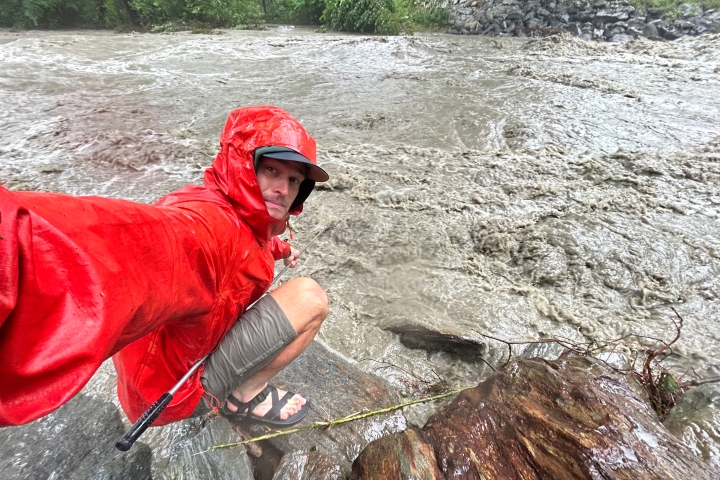The extreme weather Monday that washed out roads and flooded homes and businesses across the White River Valley set Jordan Fields, Guarini ’21, on a wild race across Vermont with a plastic water bottle on a stick to collect streamflow and sediment data from every tributary that was still accessible.
Fields, a PhD student in Earth Sciences, studies the effects of a changing climate and human disturbance on river systems.
“Because these events are so rare, it is an excellent and limited opportunity to get a look at the rate that flooding erodes the landscape,” he says. By collecting sediment samples and streamflow data across the watershed, researchers can calculate the rate of erosion and the evolution of rivers.
But another crucial question is, what if these events are becoming less rare? Monday’s flooding came just 12 years after Tropical Storm Irene devastated many of the same highways and towns in Vermont.
“If that changes, as we’re seeing, from a one-in-500-year event, as they called Irene, to a one-in-50-year, or now, a one-in-12-year event, how’s that going to affect how our landscapes and our river corridors evolve,” he says.
During the peak flows on Monday evening, as Fields was driving between the White and Williams rivers, he called in to Vermont Edition, Vermont Public’s statewide radio show, to ask listeners, if they could do so safely, to gather samples of river water in plastic water bottles and label them with the time and location of collection. On a trip back to Hanover Tuesday to drop off samples, he had heard from three or four people who joined in the research.
Normally he would enlist Dartmouth undergraduates to help, but the timing early in the summer term and the abrupt onset of the storm made that difficult. Fields knows from experience how memorable exposure to an extreme event like flooding can be to students interested in environmental sciences.
Fields was just starting his senior year at Woodstock Union High School in Vermont in 2011 when Irene swept up the East Coast.
“It flooded the school, and it flooded downtown, and a lot of my friends’ houses were flooded, and I spent the first six weeks of my senior year shoveling sediment, dirt, and debris transported by the river, out of people’s basements,” he says. “I just remember thinking where’s all this coming from, where is it going, and how are we going to deal with a climate where things like this are happening more often?”
They were already asking the same questions at Dartmouth in 2011, where researchers, led by Professor of Geography Frank Magilligan and Professor of Earth Sciences Carl Renshaw, have monitored and recorded the effects of Irene from the height of the storm to the present. Magilligan and Renshaw are Fields’ dissertation advisers and coauthors on a number of papers with the PhD student, including their most recent, A mechanistic understanding of channel evolution following dam removal in the journal Geomorphology.
Since Irene, the Dartmouth researchers have looked at how the immediate response of state and local agencies to the devastating flooding, often seen in attempts to engineer channel, lock, and dam work to stop flooding, has in fact increased destruction, flow rates, and erosion, Fields says.
Fields and the other Dartmouth researchers have been presenting their data to conservancy groups, local commissions, dam oversight boards, and many other groups to advocate for measures that will adapt infrastructure to more frequent storm incidents rather than trying to stop them, Fields says.
If there is a positive note to be gained from this week’s flooding, Fields says, it is that he is meeting more emergency responders, local officials, and contractors who are open to ideas for adapting to the changing conditions.
“People are drawing that line between what happened after Irene and what we’re seeing now and we’re trying to provide new estimates and data so that it becomes clear that we’re going to have to rethink our basic assumptions about the civil engineering,” Fields says.
“We’re going to have to adapt the way we build our bridges, roads, and downtowns so that our infrastructure is adapted to this changing climate.”
While Vermont was hard-hit by the flooding Monday and Tuesday, the Dartmouth campus saw minimal impacts, according to Frank Roberts, associate vice president, Facilities Operations and Management.
Director of Safety and Security Keiselim Montás said there were no disruptions on campus from flooding, though the docks and boathouse on the Connecticut River will remain closed until conditions improve and they are safe to reopen.
